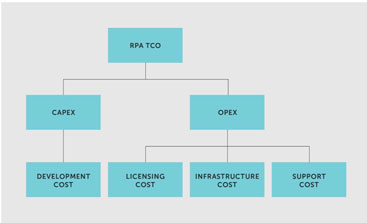THANK YOU FOR SUBSCRIBING

Building A Business Case for RPA
Pavel Gimelberg, Director, Head of Intelligent Automation Practice APAC, EPAM Systems


Pavel Gimelberg, Director, Head of Intelligent Automation Practice APAC, EPAM Systems
Creating a business case for robotic process automation (RPA) or any intelligent automation tool is often one of the most difficult, yet important, steps to embark on a successful RPA journey. There are vast degrees of opinion regarding automation ranging from “RPA is a magic potion to solve all of your business problems” to “RPA can jeopardise your efforts in creating a truly digital enterprise.”The truth is that RPA can be an effective tool, but should be handled with the same due diligence as any other investment. It’s crucial to clearly articulate the total costs and potential benefits associated with implementing RPA to get buy-in from senior leadership and make an informed decision about whether RPA is right for the business.
In the following, I’ve shared some ideas about how to put together a business case for RPA if it proves to be viable for the company.
Total Cost of Ownership
First, lets define theTotal Cost of Ownership (TCO) for RPA. Quite often, I see companies calculate ROI for RPA purely based on the cost of bot development and how quickly this cost can be recovered through ongoing efficiency savings. I would be very cautious with applying this approach. In some cases, if a company is offered free bot development, RPA might still not be viable to implement as support costs may be higher than the potential benefits.
Instead, you must consider all cost components of an RPA program from capital expenses (CAPEX) to operating expenses (OPEX) and then determine ROI by not only considering efficiency savings, but other business benefits (which we will explore later).
These cost components should be taken into account when evaluating the total cost of an RPA solution.Development Cost
Let’s start with CAPEX. It’s important to note that development costs for RPA vary depending on the size and scope of each project and company. Typically, I’ve seen businesses take a minimum of three to four weeks for development and up to eight to 10 weeks depending on the complexity of their governance structure for RPA initiatives. To automate one process, a business needs at least one full-time RPA developer, as well as one part-time Transformation Consultant, one part-time Architect and one part-time QA specialist. An optimal team structure for RPA development of four bots is one Architect, two Transformation Consultants, four RPA developers and one QA specialist, where the team works in parallel across four streams.
An easy tip for calculating how long the implementation process will take and how many resources you need to allocate is to determine how long it currently takes for the business to complete one automation process. For example, when you think about automating your email correspondence, how long does it take for you to send an email to a client through your CRM? If it takes your business about two to three minutes to complete this task, you can expect that implementing an RPA solution will take three to four weeks of development. I’ve noticed a very strong correlation between the time it takes to manually complete one iteration of the process and the development effort needed to automate this process through RPA. Now that we’ve explored CAPEX, let’s turn our attention to OPEX.
Licencing, Infrastructure & Support Costs
When determining annual operating expenses, your company should allocate for:
• Licensing Costs – This cost, like all other costs, depends on the chosen RPA vendor and volume of work, but there are certain RPA solutions that tend to cost more than others. For example, a licensing cost for an unattended bot, which lives on the server side, is usually more expensive than an attended bot, which sits on your desktop at work. Similarly, bots with cognitive abilities like machine learning or machine vision are typically more expensive than bots without this functionality.
• Infrastructure Costs – When determining your infrastructure costs, consider the type of environment where you are deploying the RPA solution. For example, deploying a bot on a virtual machine or a server might be more cost effective than deploying it on desktops. For environments that are more complex or utilise legacy technology, you can expect your infrastructure costs to be a larger component of your overall TCO.
• Support Costs – This component is the most crucial and likely the most expensive. RPA solutions need to be supported due to changes in underlying applications, changes within the processes, maintenance of virtual environments and underlying systems, and monitoring of the bot. Typically when an RPA program is in its first year, I would expect one developer to be able to support eight to 10 automated processes. In order to calculate support costs,at a minimum you should allocate for 0.1 of a developer’s FTE (assuming they are taking on 10 RPA processes). If an RPA developer has more than 10 automated processes, it’s best to allocate for a second RPA developer in your support cost calculation. After optimising support processes,this number can increaseup to 30 automated processes per developer, but it will take some time to reach this level of efficiency.
Calculating Total Costs
To calculate the TCO for an RPA program over three years, for example, use this formula:
Development Cost + (Licensing Cost + Infrastructure Cost + Support Cost) x3
Ideally the business benefits for an RPA program, andfor each process in particular, should cover this total cost. It’s important to note that any RPA initiative should have a minimum commitment for a company to be successful on their journey. For example, an RPA solution should consist of at least three to five bots, infrastructure support of at least three virtual machines plus the orchestrator/control room, and at least one RPA developer to support the technology.
Business Benefits of RPA
Now that we’ve discussed RPA costs ata high level, let’s explore the business benefits that can be achieved.
Over the past year, I’ve seen many articles citing that RPA is not about cost savings, but about providing new capabilities to the business and increasing employee satisfaction. While I completely agree with this statement, you still need to show how RPA can deliver improvements to the bottom line.For many businesses, it’s often easiest to quantify efficiency benefits, while the other benefits of RPA are sometimes difficult to calculate. Therefore, efficiency is typically the main driver for deciding to invest in RPA and obtaining budget, while the additional benefits provide a nice bonus to the program.

Here are eight potential benefits that can be achieved by effectively leveraging RPA:
Increasing Efficiency
As we already mentioned, the most common driver for a business to invest in RPA is to achieve efficiency gains. There are many ways a business can increase efficiency, including:
• FTE & Cost Reduction. The most popular benefit is through pure FTE reduction. RPA can be used to offer new services or increase the efficiency of existing services through bots instead of hiring employees to fill those roles.
• Absorbing natural attrition rates. Healthyattrition rates are important for every company, and an attrition rate of 10-12% is considered to be healthy. This means we can absorb 10-12% efficiency gains throughout the year without disturbing current organisational structure.
•Absorbing growth. If a company’s operations grow by 10% or more,RPA and next-gen technologies can absorb headcount growth that might otherwise be needed.
• Reskilling and upskilling. RPA and intelligent automation open doors for new roles, such as Botmasters, Transformation Consultants and RPA developers. Employees can be reskilled and upskilled to fill these roles, maximising the efficiency of the workforce.
•Peak time accommodation. Quite often when businesses plan for their workforce needs, there’s a good amount of buffer for peak times, such as holidays, summer hours, etc. Peak time can be easily absorbed by leveraging technology, eliminating the need for additional workforce planning to handle these particularly busy periods.
• Paid overtime reduction. For companies that pay for overtime work, RPA can take the place of employees having to work overtime.
Generating Revenue
Businesses can increase or generate revenue drivers by leveraging RPA in these areas:
• New services.RPA enables your company tobe more innovative bycreating newservices for clients that weren’teconomically feasible with manual labour.
• Faster turnaround time leads to higher sales volume. Some businesses, especially B2C businesses, can generate higher sales volumeif they respond more quickly to leads than competitors. RPA can streamline this communication process, so inquiries are being addressed as quickly as possible.
• Increased productivity .Salesagents, especially in highly specialised areas, might be scarce and difficult to find. By boosting productivity and allowing employees to focus on more high value tasks, companies can keep the same headcount and generate higher sales if the market allows for it.
Enhancing Data Quality
Data in systems of record could lack in quality due to human error or inconsistency of human behaviour, and many data analytics projects have failed due to poordata quality in IT systems. RPA eliminates the possibility of human error by logging each and every step with consistency and accuracy that no human can match. Higher data quality leads to more accurate insights about your business.
Accelerating Supply Chain Timelines
Companiescan benefit tremendously by implementing RPA to reduce supply chain cycle time. For example, let’s say a company has $100 millionfrozen in assets from procurement of materials to sell end products. With RPA, we can reduce this cycle time by 10%, freeing up $10 million in assets due to a quicker turnaround time. This one benefit could pay off the entire RPA implementation cost for a company.
Streamlining Governance
Since RPA solutions are ideal for high-volume, highly repetitive tasks, they are well-suited for heavily regulated environments. The technology logs all activities, is easy to track and identify why certain steps were performed, makes it simple to adjust tochanges and apply new regulations when needed. Completing these tasks manually would require an incredible amount of resources and would be more susceptible to error.
Simplifying Migration
As more businesses migrate from legacy systems to next-gen platforms or cloud-based solutions, RPA is an ideal solution for companies that do not have APIs or database access to these legacy systems. Deploying RPA in these cases can save time and money for the business. .
Reducing Bias
Here’s an example that explains this benefit. If a team’s daily work is distributed by a supervisor, employees could complain that the supervisor is unfairlydistributing work among them. Using RPA with clearly defined rules creates a fairer environment without bias. Another business case is to use RPA for resume screening, as some recruiters may be biased towards certain candidates. Bots do not cater to these biases unless they have been programmed and trained with the bias in mind. .
Boosting Morale
Often, employees who aren’t being challenged at work and are performing manual, tedious tasks are unhappy and unmotivated. Initially when automation first became popular, there was a lot of concern about eliminating human jobs. Instead, what we’ve found is that employees who utilise RPA technology have more control over their processes, so they can focus on more meaningful tasks without worrying if a manual, tedious task is completed.
These are the main benefits of RPA, but certainly not all the business benefits that it can provide for the company.
Key Takeaways
When making the business case for RPA and intelligent automation, it’s important to understand and communicate that, while solutions may be costly, companies can achieve significant business benefits if the technology is embraced, implemented and measured effectively.
Here are the four main takeaways from this article:
1. Always look at the total cost of ownership of an RPA program and compare it against all benefits of RPA implementation.
2. Be mindful of free RPA software or free RPA services and always calculate the total cost of the program, not one component of it. With free software or services, a company may end up paying higher costs rather than investing in a better product or better service quality in the first place.
3. Focus on efficiency benefits first – if they are enough to justify the RPA program, then it will be the fastest way to build up a business case.
4. If efficiency benefits are not enough to justify your RPA program, then look at the other benefits, such as new revenue drivers, improved data quality and accelerated supply chain cycles.
Quantifying the potential benefits and calculating ROI based on the entire cost of ownership for RPA is an essential step in yourRPA journey and when done correctly, it is the key to long-term success in leveraging RPA within the company.












